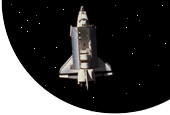Loading |
 |
|
||||||||||||||||||||||||||||||||||||||||||
Lessons of the ‘Fake Moon Flight’ Myth Depending on the opinion polls, there’s a core of Apollo moon flight disbelievers within the United States—perhaps 10 percent of the population, and up to twice as large in specific demographic groups. Overseas the results are similar, fanned by local attitudes toward the U.S. in general and technology in particular. Some religious fundamentalists—Hare Krishna cultists and some extreme Islamic mullahs, for example—declare the theological impossibility of human trips to other worlds in space. Resentment of American cultural and political dominance clearly fuels other “disbelievers,” including those political groups who had been hoping for a different outcome to the Space Race—for example, many Cuban schools, both in Cuba and where Cuban schoolteachers were loaned, such as Sandinista Nicaragua, taught their students that Apollo was a fraud. Like a counter-culture heresy, the “moon hoax” theme had been lingering beyond the fringes of mainstream society for decades. A self-published pamphlet here, or a “B-grade” science fiction movie there, or a radio talk show guest over there—for many years it all looked like a shriveling leftover of the original human inability to accept the reality of revolutionary changes. But in the last ten years, an entirely new wave of hoax theories have appeared—on cable TV, on the Internet, via self-publishing, and through other “alternative” publication methods. These methods are the result of technological progress that Apollo symbolized, now ironically fueling the arguments against one of the greatest technological achievements in human history. NASA’s official reaction to these and other questions was both clumsy and often counter-productive. On the infamous Fox Television moon hoax program, which was broadcast several times in the first half of 2001, a NASA spokesman named Brian Welch appeared several times to counter the hoaxist arguments (Welch was a top-level official at the Public Affairs Office at NASA Headquarters, who died a few months later). The poor TV impression he gave (a know-it-all “rocket scientist” denouncing each argument as false but usually without providing supporting evidence) may have been due to deliberate editing by the producers to make the “NASA guy” look arrogant and contemptuous. But to a large degree it accurately reflected NASA’s institutional attitude to the entire controversy. The disappointing results of participating seemed to strengthen the view within NASA that the best response was no response—to avoid anything that might dignify the charges. Roger Launius, then the chief of the history office at headquarters, was an exception to NASA’s overall unwillingness to engage the issue. As an amateur space historian and folklorist, I had been discussing with him for years the need for NASA to fulfill its educational outreach charter and to issue a series of modest monographs (a historian’s term for a single-theme pamphlet-length publication) on many different widespread cultural myths about space activities. These ranged from allegations of UFO sightings (and videotapings) by astronauts, to the discovery of alien artifacts on the Moon and Mars and elsewhere, to miraculous and paranormal folklore associated with space activities, to the hoax accusations. Launius, nearing retirement in early 2002, decided it was time for a detailed response to the Apollo hoax accusations, and offered me a sole-source contract to write a monograph that analyzed why such stories seemed to attractive to so many people. Launius departed NASA soon thereafter, leaving the project in the care of a junior historian, Stephen Garber. My requests for inputs from various NASA offices and public educational organizations soon reached the ears of news reporters, and some print stories appeared in late October. Although NASA officials were somewhat taken aback by the publicity, they were at first inclined to defend the project on educational grounds. Then, on Monday, November 4, 2002, the eve of the national elections, ABC’s World News Tonight anchor Peter Jennings chose the subject for his closing story: “Finally this evening, we’re not quite sure what we think about this,” he intoned. “But the space agency is going to spend a few thousand dollars trying to prove to some people that the United States did indeed land men on the moon.” Jennings described how “NASA had been so rattled” it “hired” somebody “to write a book refuting the conspiracy theorists.” He closed with a misquotation: “A professor of astronomy in California said he thought it was beneath NASA’s dignity to give these Twinkies the time of day. Now, that was his phrase, by the way. We simply wonder about NASA.” Jennings was referring to Philip Plait, an educator (not a professor) in California who runs the Bad Astronomy Web site that discusses many mythical aspects of outer space. What Plait actually had said was that he felt it was proper for NASA to respond, but that it did seem “beneath their dignity” to be forced to do it. Contrary to Jennings’s account, Plait fully supported the monograph contract. But that TV insult did it as far as NASA management was concerned. Their dignity called into question, and fearing angry telephone calls from congressmen returning to Washington after the election, they decided to revoke the contract. They paid for work done to date and washed their hands of the project. Many educators contacted me in dismay. Like them, and unlike the NASA spokesmen, I had always felt that “there is no such thing as a stupid question.” And to me the moon hoax controversy was not a bothersome distraction, but a unique opportunity. This is the way I see it: If many people who are exposed to the hoaxist arguments find them credible, it is neither the fault of the hoaxists or of their believers—it’s the fault of the educators and explainers (NASA among them) who were responsible for providing adequate knowledge and workable reasoning skills. And the localized success of the hoaxist arguments thus provides us with a detection system to identify just where these resources are inadequate. I intend to complete the project, depending on successfully arranging new funding sources. The popularity of this particular myth is a heaven-sent (or actually, an “outer-space-sent”) opportunity to address fundamental issues of public understanding of technological controversies. James Oberg (www.jamesoberg.com) worked twenty-two years at NASA Mission Control in Houston, specializing in orbital rendezvous, and is now a full-time free-lance consultant, author, speaker, and examiner of space folklore. He is a founding Fellow of CSICOP and a Skeptical Inquirer consulting editor.
|
home | profile | articles | books | lectures | jim speaks | humor
links | email
Copyright 2010 James Oberg. All Rights Reserved
Site Designed and Maintained by YoeYo.com
